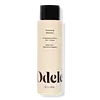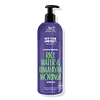What's inside
What's inside
 Benefits
Benefits

 Concerns
Concerns

 Ingredients Side-by-side
Ingredients Side-by-side

Water
Skin ConditioningSodium C14-16 Olefin Sulfonate
CleansingCocamidopropyl Hydroxysultaine
CleansingDimethyl Lauramide/Myristamide
EmulsifyingParfum
MaskingAmaranthus Caudatus Seed Extract
Skin ConditioningHydrolyzed Rice Protein
Skin ConditioningPropanediol
SolventCetrimonium Chloride
AntimicrobialPolyquaternium-10
Sodium Methyl 2-Sulfolaurate
CleansingDisodium 2-Sulfolaurate
CleansingHydroxypropyl Guar Hydroxypropyltrimonium Chloride
Citric Acid
BufferingSodium Chloride
MaskingSodium Benzoate
MaskingPotassium Sorbate
PreservativeWater, Sodium C14-16 Olefin Sulfonate, Cocamidopropyl Hydroxysultaine, Dimethyl Lauramide/Myristamide, Parfum, Amaranthus Caudatus Seed Extract, Hydrolyzed Rice Protein, Propanediol, Cetrimonium Chloride, Polyquaternium-10, Sodium Methyl 2-Sulfolaurate, Disodium 2-Sulfolaurate, Hydroxypropyl Guar Hydroxypropyltrimonium Chloride, Citric Acid, Sodium Chloride, Sodium Benzoate, Potassium Sorbate
Water
Skin ConditioningSodium Lauroyl Sarcosinate
CleansingSodium Cocoyl Isethionate
CleansingCocamidopropyl Hydroxysultaine
CleansingPEG-120 Methyl Glucose Dioleate
EmulsifyingGlycol Distearate
EmollientPropanediol
SolventCocodimonium Hydroxypropyl Hydrolyzed Rice Protein
Skin ConditioningOryza Sativa Extract
AbsorbentMoringa Oleifera Seed Extract
Skin ConditioningPolyquaternium-10
Tetrasodium Glutamate Diacetate
Phenoxyethanol
PreservativeEthylhexylglycerin
Skin ConditioningParfum
MaskingCitric Acid
BufferingCaramel
Cosmetic ColorantWater, Sodium Lauroyl Sarcosinate, Sodium Cocoyl Isethionate, Cocamidopropyl Hydroxysultaine, PEG-120 Methyl Glucose Dioleate, Glycol Distearate, Propanediol, Cocodimonium Hydroxypropyl Hydrolyzed Rice Protein, Oryza Sativa Extract, Moringa Oleifera Seed Extract, Polyquaternium-10, Tetrasodium Glutamate Diacetate, Phenoxyethanol, Ethylhexylglycerin, Parfum, Citric Acid, Caramel
Ingredients Explained
These ingredients are found in both products.
Ingredients higher up in an ingredient list are typically present in a larger amount.
Citric Acid is an alpha hydroxy acid (AHA) naturally found in citrus fruits like oranges, lemons, and limes.
Like other AHAs, citric acid can exfoliate skin by breaking down the bonds that hold dead skin cells together. This helps reveal smoother and brighter skin underneath.
However, this exfoliating effect only happens at high concentrations (20%) which can be hard to find in cosmetic products.
Due to this, citric acid is usually included in small amounts as a pH adjuster. This helps keep products slightly more acidic and compatible with skin's natural pH.
In skincare formulas, citric acid can:
While it can provide some skin benefits, research shows lactic acid and glycolic acid are generally more effective and less irritating exfoliants.
Most citric acid used in skincare today is made by fermenting sugars (usually from molasses). This synthetic version is identical to the natural citrus form but easier to stabilize and use in formulations.
Read more about some other popular AHA's here:
Learn more about Citric AcidCocamidopropyl Hydroxysultaine is a synthetic cleansing agent, though it is derived from coconut oil.
It is used to enhance the texture of products by boosting lather and thickening the texture. As a cleanser, Cocamidopropyl Hydroxysultaine is mild.
Parfum is a catch-all term for an ingredient or more that is used to give a scent to products.
Also called "fragrance", this ingredient can be a blend of hundreds of chemicals or plant oils. This means every product with "fragrance" or "parfum" in the ingredients list is a different mixture.
For instance, Habanolide is a proprietary trade name for a specific aroma chemical. When used as a fragrance ingredient in cosmetics, most aroma chemicals fall under the broad labeling category of “FRAGRANCE” or “PARFUM” according to EU and US regulations.
The term 'parfum' or 'fragrance' is not regulated in many countries. In many cases, it is up to the brand to define this term.
For instance, many brands choose to label themselves as "fragrance-free" because they are not using synthetic fragrances. However, their products may still contain ingredients such as essential oils that are considered a fragrance by INCI standards.
One example is Calendula flower extract. Calendula is an essential oil that still imparts a scent or 'fragrance'.
Depending on the blend, the ingredients in the mixture can cause allergies and sensitivities on the skin. Some ingredients that are known EU allergens include linalool and citronellol.
Parfum can also be used to mask or cover an unpleasant scent.
The bottom line is: not all fragrances/parfum/ingredients are created equally. If you are worried about fragrances, we recommend taking a closer look at an ingredient. And of course, we always recommend speaking with a professional.
Learn more about ParfumPolyquaternium-10 is an ammonium salt of hydroxyethylcellulose. It is a white and granular powder used as a film-former and anti-static agent.
This ingredient is commonly found in hair conditioning products. According to a manufacturer, its positive charge makes it great for absorbing hair proteins. The manufacturer also states this ingredient helps with curl retention.
For haircare friends: this ingredient is not a silicone.
Learn more about Polyquaternium-10Propanediol is an all-star ingredient. It softens, hydrates, and smooths the skin.
It’s often used to:
Propanediol is not likely to cause sensitivity and considered safe to use. It is derived from corn or petroleum with a clear color and no scent.
Learn more about PropanediolWater. It's the most common cosmetic ingredient of all. You'll usually see it at the top of ingredient lists, meaning that it makes up the largest part of the product.
So why is it so popular? Water most often acts as a solvent - this means that it helps dissolve other ingredients into the formulation.
You'll also recognize water as that liquid we all need to stay alive. If you see this, drink a glass of water. Stay hydrated!
Learn more about Water